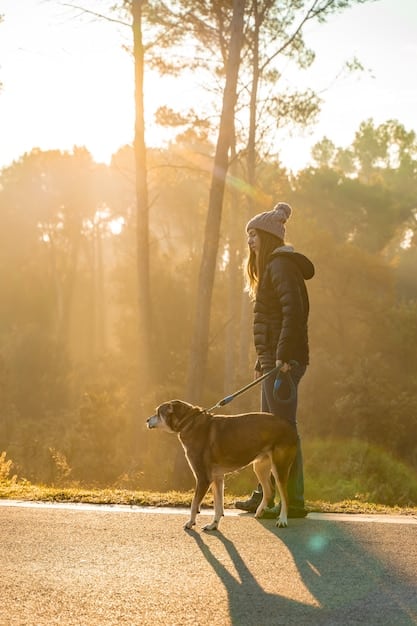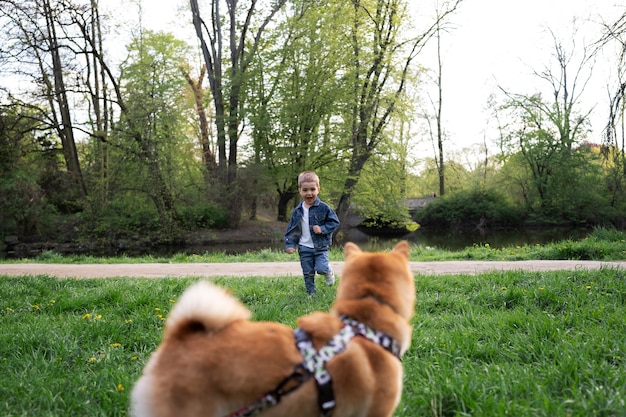Leash Reactivity Breakthrough: Reduce Lunging by 50% in 2 Weeks

Discover a **leash reactivity breakthrough** that promises to reduce your dog’s leash lunging by 50% in just two weeks, offering a comprehensive guide to understanding, addressing, and overcoming this common behavioral issue.
Is leash reactivity turning your walks into stressful events? A **leash reactivity breakthrough: Reduce lunging by 50% in 2 weeks** using our tested and proven methods designed to transform your dog’s behavior on the leash, turning those stressful outings into enjoyable experiences for both of you.
Understanding Leash Reactivity
Leash reactivity is a common yet frustrating issue for many dog owners. It’s essential to understand what it is and why it happens before attempting to correct the behavior. Recognizing the triggers and underlying causes can pave the way for effective training.
What is Leash Reactivity?
Leash reactivity is when a dog overreacts to stimuli while on a leash. This often presents as excessive barking, lunging, growling, or pulling when they see other dogs, people, cars, or any other trigger. The dog isn’t necessarily aggressive; rather, they become overly excited or anxious when restrained by the leash.
Why Dogs Develop Leash Reactivity
Several factors lead to leash reactivity. Frustration plays a significant role; the leash prevents the dog from greeting or interacting with triggers, leading to pent-up energy and frustration. Fear or anxiety can also cause it, particularly if the dog has had negative experiences in the past or feels vulnerable on the leash. Genetics and lack of socialization during crucial puppyhood can also contribute.
- Frustration: The leash limits the dog’s ability to interact, causing frustration.
- Fear/Anxiety: Negative experiences can make the dog feel vulnerable.
- Lack of Socialization: Insufficient early exposure to various stimuli.
- Genetics: Some breeds are predisposed to reactivity.
Understanding these factors is the first step in addressing leash reactivity. Identifying the specific triggers and emotional state behind your dog’s reactions will allow you to tailor your training approach effectively.

Assessing Your Dog’s Reactivity
Before implementing any training program, it’s essential to assess the severity and triggers of your dog’s leash reactivity. This assessment helps individualize your training approach and track progress effectively. A careful evaluation will highlight what provokes your dog and how intensely they react.
Identifying Triggers
Pinpointing the exact triggers that set off your dog’s reactivity is crucial. This can involve observing your dog during walks and noting what specific sights, sounds, or smells cause a reaction. Keep a journal to record these triggers, noting the context and intensity of the reaction.
Measuring Reactivity Levels
Quantifying the intensity of your dog’s reaction can help track progress. Use a scale, such as 1 to 5, where 1 represents mild interest or attention and 5 represents extreme barking, lunging, and aggressive behavior. Regularly assessing and recording these levels will provide a clear picture of how your training is working.
Assessing your dog’s reactivity accurately allows you to set realistic goals and make informed decisions about your training. It provides a baseline to measure improvements and helps tailor the training to your dog’s specific needs, ultimately leading to more effective and lasting results.
The 2-Week Training Program
This two-week training program is designed to reduce your dog’s leash lunging by 50%. It combines various techniques, including desensitization, counter-conditioning, and positive reinforcement. Consistency and patience are key to success.
Week 1: Foundation and Desensitization
The first week focuses on building a strong foundation and beginning the desensitization process. Start by teaching your dog basic commands like “look at me” and “leave it.” These commands will be crucial for redirecting their attention during walks.
Week 2: Counter-Conditioning and Generalization
The second week builds on the foundation and focuses on counter-conditioning. Pair the appearance of triggers with positive experiences, such as treats or praise. Gradually increase the proximity to the triggers while maintaining a calm and positive environment.
- Day 1-3: Basic command training (look at me, leave it).
- Day 4-7: Controlled exposure to low-level triggers.
- Day 8-11: Implementing counter-conditioning techniques.
- Day 12-14: Generalizing training in different environments.
By systematically working through these steps, you can significantly reduce your dog’s leash lunging in just two weeks. Remember to adjust the pace based on your dog’s individual progress and always maintain a positive and supportive approach.

Tools and Techniques for Success
Using the right tools and techniques can significantly enhance the effectiveness of your leash reactivity training. From specialized equipment to specific training methods, these resources can help you manage and modify your dog’s behavior.
Choosing the Right Equipment
The type of equipment you use can impact your dog’s comfort and behavior during walks. Consider using a front-clip harness, which offers better control and reduces strain on your dog’s neck. Avoid using choke collars or prong collars, as they can cause pain and worsen reactivity.
Effective Training Techniques
Positive reinforcement is one of the most effective techniques for addressing leash reactivity. This involves rewarding your dog for calm and appropriate behavior around triggers. Other techniques include redirection, where you redirect your dog’s attention to you with a command or treat, and creating distance from triggers.
Selecting the appropriate tools and incorporating effective training techniques can make a substantial difference in your dog’s leash reactivity training. These resources can improve your control and communication, fostering a better and calmer walking experience for both you and your dog.
Maintaining Progress and Preventing Relapses
Once your dog has shown improvement in leash reactivity, it’s essential to maintain progress and prevent relapses. Consistent reinforcement and ongoing training can help solidify new behaviors and address any emerging issues.
Consistent Reinforcement
Continue to reinforce calm behavior on walks by rewarding your dog with treats and praise when they remain relaxed around triggers. Regular reinforcement helps your dog associate positive experiences with potentially reactive situations, reinforcing their new, calm behavior.
Addressing Setbacks
Setbacks are a normal part of the training process. If your dog regresses, don’t get discouraged. Revisit the steps of the training program and identify any new triggers or factors contributing to the relapse. Adjust your approach accordingly and continue with patience and consistency.
Maintaining progress involves ongoing reinforcement, addressing setbacks promptly, and adapting your training to your dog’s changing needs. Continuous effort ensures your dog remains calm and manageable on the leash, fostering a long-term positive walking experience.
Advanced Strategies for Stubborn Cases
Some dogs may require more advanced strategies to overcome leash reactivity. In these stubborn cases, it’s important to explore additional techniques and seek professional guidance.
Seeking Professional Help
If you’re struggling to make progress on your own, consult with a certified professional dog trainer or a veterinary behaviorist. These experts can provide personalized guidance, assess underlying issues, and develop a tailored training plan.
Medication and Alternative Therapies
In some cases, medication may be necessary to manage anxiety or aggression contributing to leash reactivity. Consult with your veterinarian to discuss appropriate medication options or explore alternative therapies like acupuncture or herbal remedies, which can help calm your dog.
Incorporating professional guidance and exploring advanced strategies can provide hope and solutions for stubborn cases of leash reactivity. Seeking expert help can offer insights, leading to significant improvements in your dog’s behavior and overall well-being.
| Key Point | Brief Description |
|---|---|
| 🐶 Understanding Triggers | Identify what causes your dog’s reactivity. |
| 🐾 Two-Week Program | Desensitization & counter-conditioning. |
| 🦴 Positive Reinforcement | Reward calm behavior around triggers. |
| 👨⚕️ Professional Help | Seek advice for stubborn cases. |
Frequently Asked Questions
▼
Leash reactivity is when a dog overreacts to stimuli while on a leash. This often includes barking, lunging, or growling at other dogs, people, or objects.
▼
Observe your dog during walks and note specific things that cause them to react. Common triggers include other dogs, people, cars, or loud noises.
▼
A front-clip harness is recommended for better control, and positive reinforcement techniques with treats and praise are highly effective.
▼
Don’t be discouraged. Revisit the steps of the training plan, identify new triggers, and adjust your approach while maintaining patience and consistency.
▼
If you struggle to make progress on your own, consult with a certified dog trainer or veterinary behaviorist for personalized guidance and a tailored plan.
Conclusion
Overcoming leash reactivity requires patience, consistency, and the right techniques. By understanding the underlying causes, assessing your dog’s triggers, and implementing a structured training program, you can significantly improve your dog’s behavior on the leash. Remember to celebrate small victories and reach out for professional help when needed, creating a more enjoyable walking experience for both you and your furry friend.





